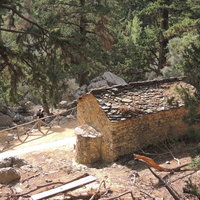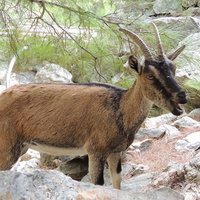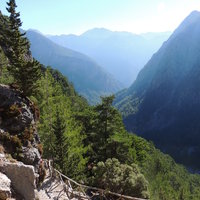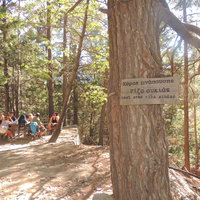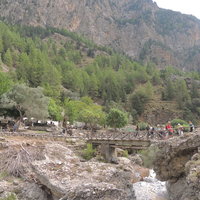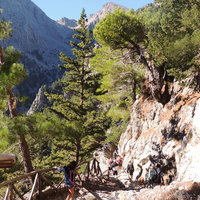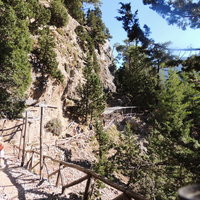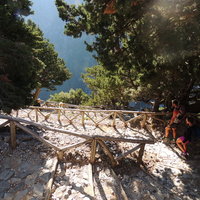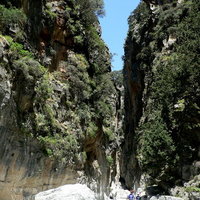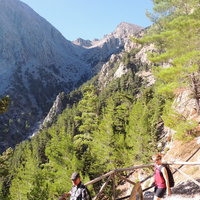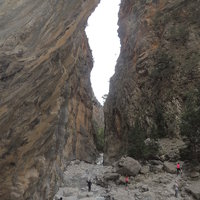Walking the Samaria Gorge is an incredible experience but one that should be considered carefully. It generally takes between 4 – 6 hours to walk the gorge. It should not be attempted by anyone with back or knee problems, or anyone who is generally very unfit. If you get into the trouble in the gorge, the only way out is on the back of a donkey with a large red cross on its side! Having said that, I have had active elderly people manage the walk with ease, and teenagers who have made very hard work of the gorge.
Almost everyone, including myself (unfit as I am) that I know who has walked Samaria, has been very glad that they experienced the beauty of the gorge and very achy for a number of days afterwards.The best way to walk the Samaria Gorge is to take an excursion coach – this is because there are no roads in or out of Agia Roumeli (at the bottom of the gorge) therefore you have to take a ferry that leaves you a long way from your car (if you have driven to the top of the gorge).
The organised excursion saves you all of the different logistical transportation problems, it also means that you don’t have to drive when you are very tired. The excursions start very early in the morning (5.15am onwards) but this is necessary as it is best to start the gorge walk early in the morning for a number of reasons. The earlier that you start, the cooler the temperature will be, also you have to be in Agia Roumeli in time to catch the ferry that will take you along the south coast, back to the coach.
Despite being on an organized trip, you can still go down the gorge at your own pace – you do not walk through the gorge as a group. You are given your entrance ticket for the gorge by the guide on the coach, you must keep it in your possession for the entire walk, as half of it is taken at the exit of the gorge, in order to check that no-one is lost in the gorge overnight. The guide will give you a meeting time and place in Agia Roumeli, so that she can guide you on to the correct ferry and then onto the correct coach. You are therefore on your own to walk the gorge at our own pace.
The Samaria Gorge is the longest gorge in Europe and it is full of indigenous flora and fauna. Most of the guide books will tell you that the gorge is 18kms long – it is not. The walk comprises of 13km in the gorge itself, and then approximately another 2.5kms on a hill down into the village of Agia Roumeli.
When walking the gorge, you must be very careful and look at your feet whilst taking every footstep. It is very easy to slip of twist and ankle if you do not pay attention to where you are going. It is best to stop walking when you want to look around you at the wonderful scenery. The walk is mostly downhill and starts at Xiloscalo (wooden staircase). The first section of the gorge is wonderfully cool and alpine (the gorge walls are not particularly evident but the gorgeous smell of pine is). It is initially quite steep but there is a well-worn staircase and path to follow.
The middle section of the gorge is a gently undulating path and has the abandoned village of Samaria and the 1379 chapel of Osia Maria (The name Samaria is a deviation of this – Sia Maria). The last inhabitants of the village of Samaria were moved to Agia Roumeli in 1962 when the area officially became a national park. Samaria was originally designated as a nature reserve as early as 1929, when ecologists realised that the agrimi (Cretan ibex) more commonly known as the “Kri Kri” goat, faced possible extinction. The bottom section of the gorge is where you walk along the rocky river bed and walk across small bridges that criss cross over the Tarraios River. This is where the sun is at its strongest, there is no natural shelter, and where the gorge walls are at their highest. The famous Sideroportes (Iron Gates) that you see in all the photos are in this bottom section of the gorge, and are approximately 2000ft high. All the way through the Samaria Gorge there are springs and water fountains, rest areas with benches, and toilets in wooden cabins. For the 13km that you are in the gorge itself, there are stones marking every kilometre. At the 13th kilometre mark you come to the exit of the gorge where there are the ticket collectors and 2 refreshment kiosks. From here you are walking downhill with no shade to Agia Roumeli. The last section of the walk is hot and you are looking at the deep blue Libyan Sea the whole way.
When you reach Agia Roumeli you will find many cafes and tavernas and a black sand beach with sun-beds. You may want to eat something, and you will definitely want to take a swim in the refreshingly cool waters of the Libyan Sea. At this point you will want to take off your walking boots – make sure that you have some sandals or flip-flops with you as the black sand is incredibly hot and impossible to walk on in bare feet. Most people have a couple of hours to relax in Agia Roumeli before it is time to catch the ferry.
At the designated time you will meet the guide who will give you a ferry ticket and lead you to the correct ferry for Chora Sfakion, or sometimes to the ferry to Sougia where the coach will be waiting to bring you back to the north coast.
The ferry has seats on an open-air upper deck, and a sheltered lower deck. There is a bar where you can buy refreshments and there are toilet facilities on board. The journey generally takes about 45 minutes to an hour and is the perfect opportunity to relax and look for dolphins.
Points to remember when walking Samaria Gorge: I cannot recommend strongly enough taking an excursion coach for ease and accessibility. Only ever wear good walking boots or trainers with a thick sole (the terrain is rough underfoot and you would be in agony in unsuitable footwear). Please do not consider wearing anything with open toes (even walking sandals), as the boulders on the riverbed at the bottom will easily give you black toenails. An old army trick that really works is to spray your feet with antiperspirant as this limits the chance of getting blisters. Take a sweater with you as it is quite cool first thing in the morning at the top of the gorge. The breakfasts at Omalos can be over-priced so may like to consider taking your own with you. Take a small backpack for carrying everything. Always take plenty of sunscreen and a hat – the gorge is very open in the bottom section, which you will be walking at mid-day. Take a snack and a small bottle of water with you that you can re-fill regularly at the springs and water fountains. Take your swimsuit, a small towel and some flip-flops for the beach at Agia Roumeli. You will also want to take a small amount of money for food and drinks at Agia Roumeli, and your camera. When in the gorge, always pay attention to where you are going, and stop to look around at the amazing scenery. Always be on the lookout for the birds of prey that float around in the thermals above the gorge, amongst them eagles, the rare griffon vulture, and the even rarer lammergeier. Also look out for the rare Kri-Kri goat – it has a black stripe down its back, and the indigenous plants and trees of Crete.
